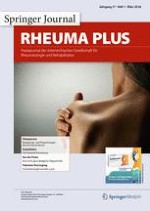Anzeige
18.01.2018 | Osteoporose
Bewegungs- und Physiotherapie bei Osteoporose
Erschienen in: rheuma plus | Ausgabe 1/2018
Einloggen, um Zugang zu erhaltenZusammenfassung
In Reaktion auf die Muskelarbeit gegen die Schwerkraft regulieren Osteozyten, Osteoklasten und Osteoblasten während des gesamten Lebens die Formation und Resorption von Knochengewebe. Ein progressives Widerstandstraining für alle großen Muskelgruppen und Aktivitäten mit Belastungen durch das eigene Körpergewicht haben einen positiven Effekt auf die Knochendichte. Derartige regelmäßig durchgeführte Aktivitäten erhöhen die Knochendichte oder bremsen zumindest deren physiologischen Abbau. Übungen mit niedriger Intensität und ohne Körpergewichtsbelastung zeigen keinen Effekt auf die Knochendichte. Eine Bewegungstherapie bei Patienten mit Osteoporose muss dies berücksichtigen. Eine Remobilisierung nach Frakturen muss mit dem Ziel, den Knochendichteverlust durch Inaktivität zu vermeiden, rasch eingeleitet und, falls erforderlich, durch eine Schmerztherapie ergänzt werden. Ziele einer rehabilitativen Bewegungstherapie sind die Erhaltung oder Verbesserung der Gelenkbeweglichkeit und Körperbalance und die Muskelkräftigung zur Vermeidung des Rundrückens und zur Funktionserhaltung von Armen und Beinen. Eine enge Zusammenarbeit der Physiotherapeuten mit den behandelnden Ärzten ist für den Therapieerfolg Voraussetzung. Der Übungsaufbau muss progressiv und an den individuellen Trainingsstatus sowie das Frakturrisiko adaptiert sein. Dynamische Aktivitäten mit Rumpfflexionen erhöhen das Risiko von vertebralen Kompressionsfrakturen. Sportarten mit erhöhter Sturzgefährdung müssen vermieden werden. Eine Unterforderung des Osteoporosepatienten bei körperlichen Aktivitäten ist nicht zielführend.
